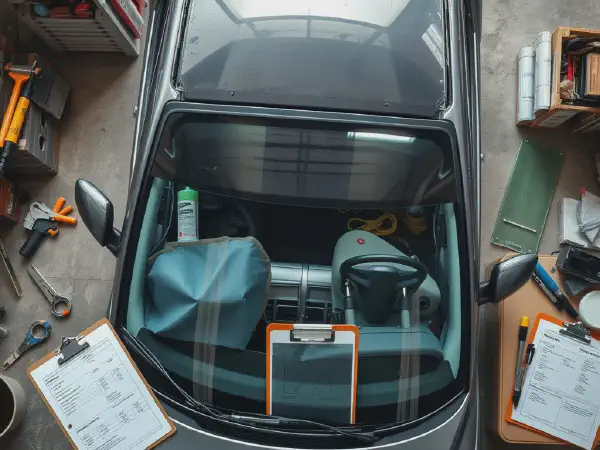Essential Guide to Windshield Replacement Costs and Tips

The Complete Guide to Windshield Replacement
Windshield Replacement is an essential service for vehicle safety and functionality. Whether due to cracks, chips, or other damage, having a functional windshield is crucial for clear visibility and protecting passengers from the elements. Ignoring windshield damage can lead to serious safety risks and potentially costly repairs down the line.
There are various reasons one might need a Windshield Replacement, ranging from weather-related issues to accidents and even vandalism. It's important to recognize that a damaged windshield not only affects sight but also compromises the structural integrity of the car. Proper replacement is crucial for maintaining the safety features built into modern vehicles.
Choosing the right time for a Windshield Replacement can save you money and ensure your safety on the road. If a chip or crack is more than a couple of inches long, it’s typically best to opt for a full replacement. Additionally, environmental factors such as extreme temperatures can exacerbate existing damage, making timely intervention even more crucial.
For unbeatable quality and service in windshield repair, trust the experts at Hammond Autoglass.
When it comes to Windshield Replacement, professional services are often recommended for ensuring quality installation. However, some vehicle owners may consider DIY methods. Whichever route you choose, understanding the factors affecting replacement costs is imperative for making informed decisions.
In conclusion, investing in a Windshield Replacement is about much more than aesthetics—it's about safety and integrity. With the right knowledge and resources, you can navigate the windshield replacement process effectively, ensuring that you and your passengers are protected while on the road.
Understanding Windshield Replacement Costs
The costs associated with Windshield Replacement can vary greatly based on several factors. These may include the make and model of the vehicle, the type of glass used, and the labor charges in your area. Additional factors such as the location of the damage, specific features like tinting or sensors embedded in the glass, and whether special adhesives are needed can also affect pricing.
On average, windshield replacement can range from $200 to $1,000, depending on the factors mentioned. Standard sedans generally have lower replacement costs compared to high-end vehicles or those with advanced safety features. For example, a typical replacement on a basic sedan may cost between $200 and $400, while high-end vehicles can see costs exceeding $1,000.
Insurance coverage can be a deciding factor in the overall cost of windshield replacement. Many insurance policies offer glass coverage, which may cover the entire cost or provide a deductible option. It's advisable to check your insurance policy to understand what is covered and to find authorized repair shops that will work with your insurance provider.
DIY Windshield Replacement
If you are considering a DIY Windshield Replacement, it's important to gather the right tools beforehand. Essential tools typically include a windshield removal tool, adhesive, a caulking gun, and safety goggles. Ensure you have someone to assist you as this is a two-person job, especially when lifting the glass.
To carry out a DIY windshield replacement, follow this step-by-step guide: 1. Remove any broken glass and debris. 2. Use the windshield removal tool to cut around the old windshield. 3. Apply adhesive according to product instructions. 4. Carefully position the new windshield into place with assistance. 5. Ensure it is sealed properly and allow the adhesive to cure as per the manufacturer's recommendations.
Common mistakes to avoid during DIY windshield replacement include inadequate cleaning of the frame, failing to apply enough adhesive, and misalignment of the windshield during installation. These errors can lead to leaks, further damages, and compromised safety.
Choosing the Right Windshield Replacement Service
When selecting a windshield replacement service, look for factors such as experience, customer reviews, and warranties offered. A reputable service will provide a guarantee on their workmanship and materials, giving you peace of mind regarding the quality of the replacement.
Before hiring a technician, consider asking key questions such as: What brands of glass do you use? Do you offer mobile service? What is your warranty policy? These inquiries can help gauge the service's reliability and professionalism.
Check for reviews and certifications of windshield services online. Positive feedback from previous customers can indicate a trustworthy service. Additionally, look for businesses certified by organizations like the Auto Glass Safety Council (AGSC) to ensure they adhere to industry standards.
Windshield Replacement Safety Standards
Understanding safety standards for windshields is crucial. Regulatory bodies such as the National Highway Traffic Safety Administration (NHTSA) have established standards ensuring that automobile windshields can withstand impact and adhere correctly to vehicles. Familiarizing yourself with these standards can help you make informed decisions when choosing materials and services.
Using Original Equipment Manufacturer (OEM) versus aftermarket windshields can significantly affect safety. OEM windshields are designed specifically for your vehicle's make and model, ensuring the best fit, while aftermarket options may not meet the same safety and quality standards. Researching the differences can help you choose the best option for your safety.
Proper installation is critical for maintaining vehicle safety. An incorrectly installed windshield can compromise airbag deployment and structural integrity during a collision. Ensuring that your replacement is done by certified professionals or following proper DIY guidelines is crucial for safety on the road.
Aftercare Post Windshield Replacement
After a windshield replacement, maintaining the new installation is important. Avoid washing your car or exposing it to extreme weather conditions for at least 24 hours to allow the adhesive to cure completely. Regular inspections can help detect any issues early before they escalate.
Watch for signs of poor installation such as water leaks, wind noise, or visible gaps around the windshield. If these issues arise, contact your service provider immediately to address potential problems before they lead to further complications.
As a rule of thumb, it’s best to wait at least one hour before driving your vehicle after installation, though checking the adhesive manufacturer's guidelines is advisable. This wait time can help ensure that the windshield is securely in place.
